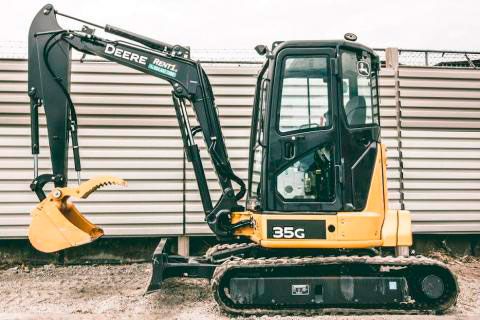How to Remove a Tree Stump with a John Deere 35G
A John Deere 35G is one of the most durable, versatile mini excavators on the market, true to its history and the simple beginnings of its founder, John Deere. In 1835, Deere was a humble, yet accomplished blacksmith known for getting things done with the resources available. Most of his clients were farmers, and they had a problem. Their plows, made for the sandy earth in the Eastern United States, kept breaking in the hardscrabble prairie soil of the Midwest. Deere quickly repurposed a broken saw blade into a steel mold and was then able to forge a new, more durable plow. The next year, he became a full-fledged manufacturer, and an American legend was born. Fast-forward more than 180 years, where the 35G excavator continues to live up to that rich heritage.

Reasons Your Customer Wants that Tree Stump to Disappear
Whether you work for someone else or are an owner-operator catering to smaller clients, a John Deere 35 G is the perfect machinery for getting work done efficiently and on-time. Compact but powerful, it was designed with input from owners and operators to excel in many environments and industries – from near-frozen construction sites in the big cities to blazing hot landscaping and everywhere in between.
If your tasks are residential tree removal, then you could not have picked a better product than this one. Today, you are onsite for a residential customer with a few tree stumps that need to be removed. As you talk your client through the job, he identifies just why those stumps must go – and you find yourself nodding in agreement:
- Sometimes tree stumps are butt-ugly and just must go.
- Lately, your customer has noticed the stumps have become the communal meeting spot for all sorts of critters: Squirrels, bees, birds and, worst of all, the neighborhood skunk.
- Your customer has a houseful of kids who play in the backyard with friends, and the tree stumps are a potential hazard. Nothing says, “lawsuit” like kids not watching where they are running, with a tree stump in the middle of the yard.
- Wow, look at that gnarly growth sprouting from the side of one of the stumps! It sure looks creepy, and did you forget your customer has kids?
- Tree stumps get in the way of cutting the grass.
- Your customer is planning for a built-in pool, so the stumps have to go.
- Removing a tree stump is hard work, which is why your customer gave you a call.
- The customer also pointed out roots on the run, interfering with his lawn and garden.
- A realtor said they had to be removed before the house can be put up for sale.
How to Remove a Tree Stump with a John Deere 35G
- First, get your John Deere 35G to the client location, ideally by transporting it on a flatbed trailer.
- Make sure to park somewhere the trailer will not interfere with vehicles, pedestrians, or anything else in its path.
- If you have not done so recently, reacquaint yourself with the operator’s manual.
- Ideally, you have a co-worker who can guide you as you drive the excavator off the trailer. Use caution, and go slow.
- Take a moment to assess the job site, noting the location of the customer’s residence, a flower bed, patio, and so forth.
- To be safe, try digging out the ground around the stump first before trying to remove it.
- If large, above-ground roots are near the stump, remove them first.
- As you remove rocks, dirt, chunks of roots, or other debris, make sure to deposit it safely away from the work area – preferably in a dump truck.
- As soon as you have removed all visible roots, it is time to go at it with the John Deere 35G bucket. And yes, you will need multiple attempts to completely remove it.
- You can rock the stump back and forth using the bucket from different angles.
- With the stump loosened, you can now angle the excavator bucket underneath it and lift slowly to lessen the risk of a tip-over.
- Finally, you can safely remove the tree stump from the ground.
Follow These Safety Tips
Your John Deere 35G mini excavator makes tree stump removal a nearly-simple chore, but such tasks are can be dangerous if done haphazardly or without following safety procedures. The Government of Canada offers the following tips if you are using heavy machinery to remove a tree stump.
- Determine the location of utility lines above grade or below ground and always work as if they were “live.”
- Your local utility normally has a toll-free number you can call to have someone come out and place marker flags where power, water, and sewer lines are located before you start digging.
- What is the minimum working distance between power lines and tree stumps? Your local municipality should be able to give that information.
- The John Deere 35G is simple, designed to be operated by one person, but it is always a good idea to have a spotter nearby.
- It is your responsibility to ensure the work area is free of pedestrians, animals, vehicles, or anything else that may pose a safety risk.
- Watch the weather forecast and do not try to remove a tree stump during bad weather.
- Only operate your John Deere 35G or other heavy machinery if you are trained to do so.
- Use safety equipment as recommended, such as safety glasses, gloves, hard hats, and noise-canceling headphones.
- Be wary of flying debris when removing tree stumps.
What Else Do You Need to Know?
Like any other job, removing tree trunks is the serious business that should not be taken lightly. Even if you are a “seasoned” stump removal expert, there is no such thing as an abundance of information. Here are other questions to think of before starting work, some of which may give you a sense of what your customer is thinking.
- Do you know what species the stump was part of? Trees that grow tall and strong have tap roots to support heavy upper body weight are usually the hardest to dig out. Trees whose stumps are among the toughest to remove belong to the following species: hickories, white oaks, and walnuts.
- Do you have to do any spot-digging to see how large the roots are?
- Roots are notorious for branching in all directions, but where?
- Proceed cautiously if it looks as if the roots snake under a structure or hard surface area.
- Are you licensed and insured to perform the work for which you have been hired? Accident insurance is a must-have.
- Is your work limited to a certain time of day?
- Do you have access to a dump truck or other large vehicle to haul away the stumps or other debris?
Finally, do you need a license the do the stump removal?
Like This, Not That
Some tree stumps can be removed by hand, and can often be done with minimal effort in a few hours. If the stump is large and old, using a John Deere 35G is the way to go. But how? Every landscaping professional has a go-to method for this sort of work. Here are a few ideas to help along the way.
- Give yourself work room by digging out around the stump first.
- The work should only be done if the weather cooperates.
- Stump removal should not present a hazard to structures or other parts of the property, like the owner’s residence, playscape, patio, and so forth.
- Think about using a thumb attachment to make the bucket more efficient.
- The ground beneath and around the stump can be used as leverage for the bucket.
- The excavator blade is great for breaking the stump free of its roots.
- A hydraulic hammer is useful for breaking the stump into smaller chunks once it’s free of the ground.
- Pay attention to your surroundings, especially for people or animals in the area.
Choose the Best, Choose a Deere
There may be no other piece of heavy machinery as useful for removing tree stumps than a mini excavator. The John Deere 35G excavator was built with the customer in mind, and only after receiving feedback from owners and operators who use it daily. The 35G is available with numerous standard and optional features, such as:
- A high-efficiency diesel engine compliant with government emission standards.
- Ergonomic seating in a cab with large windows for a clear view of the work area.
- A canopy to make the excavator usable in multiple weather conditions.
- Power ports, making it easy to charge cell phones and other devices.
- Monitoring systems so you know how the machine is functioning.
- Multiple work modes.
- The option to make the 35G quieter and more fuel thrifty, thanks to an engine that runs at lower RPMs.
The John Deere 35G is uniquely capable for many tasks, large and small. If you are committed to getting the job done efficiently and on time, only choose Deere.

